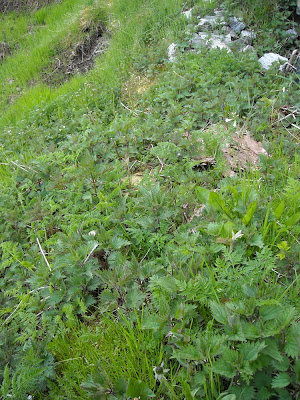
Most people know that I'm a big fan of Nancy van den Boom's work. I love her work and the way she uses color and light. I mentioned this already in an interview that I did with her a few months ago.
Before I come back to a new examination and opinion of Nancy's work, I need to refer to a recent documentary I had seen a few months ago. It was an anthropological study on art. The most significant importance of the program I took with me was this: globally speaking, the landscape painting (or photograph in recent years) is the most popular with human beings. There is something about a landscape painting that goes straight into the primitive core of people and speaks directly to their feelings of safety and well being. And of all landscape paintings, the most popular of these are those that contain 4 features: water, a possibility for shelter, fertility of surrounding area and 'a way out'. By a way out, I mean a pathway, a stretch of openness, or an area of the painting that one can imagine travelling to. This final point fullfills the intrinsic need in almost all humans of seek out unexplored areas or experience new ideas.
Nancy's work displays all of these four features and does it in a way that is much more 'delightful' that what I've seen in other landscape paintings.
While not all of Nancy's paintings feature water that can be directly seen, her work is so full of greenery and color that it implies that water, and a great deal of water at that, is easily obtainable. In addition, there's always something in Nancy's work that is both calming and exciting at the same time. It has taken me a while to put words to it, but I've come to realize that looking into Nancy's work makes me fantasize about being in the world she creates. I can see myself having to work, yes, but having to work much less - perhaps only a few hours a day. Everything is fruitful and the people are happy in visual worlds that Nancy captures. It's a place where it rarely rains, and when it does, it's just enough to keep everything as it should be.
As a final comment, as much as I love Nancy's work I am certainly not in the place in my life right now where I can drop down 500+ American dollars for one of her pieces (which I think should be sold for more.... but we don't need to tell her that). As a mother of two small children, a mortgage, a 'regular' job, etc, 500+ dollars is always better spent on other items, usually involving the needs of the children.
I mentioned this to Nancy a few months ago, and asked her what would be the price of a much smaller painting. She almost immediately produced a tiny piece and showed it to me. And since then she's created many small paintings. I have liked them all to varying degrees, but when I saw this sea side landscape I knew it was the one for me.
So now I can say that I have purchased my first oil painting: a small 10 cm by 10 cm canvas. I love it already and cannot wait for it to arrive in the mail. And it costed me just under 30.00 USD - perfect for my budget at the moment. I hope to collect more in the future, with possibly a few larger pieces as the children start leaving home.
It's not often that a purchase makes me feel so good - I am generally not a very materialistic person. While I am sure I will love this painting as long as I am around to see it, I do hope one day in the future my grandchildren can say 'Our grandmother knew and communicated with that famous artist in the Netherlands.'
We will have to wait and see.








































































